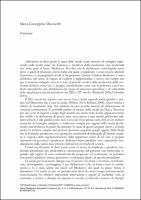Chapter Prolusione
| dc.contributor.author | MUZZARELLI, MARIA GIUSEPPINA | |
| dc.date.accessioned | 2022-06-01T12:29:40Z | |
| dc.date.available | 2022-06-01T12:29:40Z | |
| dc.date.issued | 2022 | |
| dc.identifier | ONIX_20220601_9788855185653_793 | |
| dc.identifier.uri | https://library.oapen.org/handle/20.500.12657/56609 | |
| dc.description.abstract | Divided into ten points, this paper aims to illustrate how fashion produced modernity, understood as valuing the present, especially its progressive and evolving elements. A process that focused on amplifying “personal visibility”, and in which the abilities of tailors played a crucial role. The effects on the economy of “modern” fashion, born in the Middle Ages, have been significant. Since the thirteenth century, treatisers and preachers, as well as legislators, focused on the way people dressed as a means to regulate society, while artisanal shops invented, ever so often, new objects and prepared unseen social and political scenarios. For all these and many other reasons, we can state that fashion moved and was a metaphor of modernity. | |
| dc.language | Italian | |
| dc.relation.ispartofseries | Datini Studies in Economic History | |
| dc.subject.other | Economic history | |
| dc.subject.other | fashion | |
| dc.subject.other | textile history | |
| dc.subject.other | preindustrial economy | |
| dc.title | Chapter Prolusione | |
| dc.type | chapter | |
| oapen.identifier.doi | 10.36253/978-88-5518-565-3.02 | |
| oapen.relation.isPublishedBy | bf65d21a-78e5-4ba2-983a-dbfa90962870 | |
| oapen.relation.isbn | 9788855185653 | |
| oapen.series.number | 2 | |
| oapen.pages | 8 | |
| oapen.place.publication | Florence |

